SanDisk Extreme SSD 240 GB Review

SanDisk Extreme SSD uses SF-2281 controller and 24 nm flash memory made by SanDisk. We have never a seen a combination like that before, so it is particularly interesting to check it out and see if contemporary Toggle Mode NAND will be able to breathe new life into the second-generation SandForce-based platform.
SandForce series controllers have acquired a lot of opponents among users. Some still remember that early SandForce-based SSDs used to be plagued by stability issues. Others do not like the performance hit such SSDs suffer as they transition from their out-of-box into steady state. SandForce controllers are even regarded as cheats because their performance depends on the type of processed data and SSD makers try to conceal this fact, specifying the best-scenarios speed only.
On the other hand, there is no denying the fact that SandForce-based SSDs are hugely popular. The developers of this hardware platform have managed to please both SSD makers and SSD users. The former are enticed by the simplicity and flexibility of the SandForce solution whereas the latter are ready to put up with its downsides as long as it offers an excellent price/performance ratio. So, if you take a look at any price list with PC components, you are sure to find the SSD category occupied by SandForce-based products.
Recalling our numerous reviews of SSDs with SF-2281/SF-2282 controllers, we can categorize all such products into four groups. The first one includes SSDs from Intel with exclusive firmware which makes them faster than other brands’ SSDs with the same hardware (synchronous flash memory with ONFI interface). The second group includes a lot of reference-design SSDs with the same hardware as Intel’s but with reference firmware. The third group is comprised of SSDs with asynchronous flash memory that are slow but cheap. And the fourth and smallest group includes rather fast SSDs in which the SandForce controller works with Toggle Mode NAND flash memory.
This classification helped easily sort out any consumer-class SSDs with SF-2281/SF2282 controllers in terms of performance, so we could often avoid benchmarking a new SSD in depth by simply pointing at its similarity to products tested earlier. However, the situation seems to be changing, so the SandForce platform needs a new look.
These changes result from the fact that 32 nm flash memory with Toggle Mode interface, employed for the fourth-group SSDs according to our classification, has been all used up. The manufacturers of such memory, Toshiba and SanDisk in the first place, have long transitioned to more progressive technologies, 19 and 24 nm. The natural outcome of this situation is the emergence of a new class of SandForce-based SSDs which use such memory. Today we’ve got the first SSD that combines the good old SandForce SF-2281 controller with new 24 nm Toggle Mode flash. The innovative product is called SanDisk Extreme SSD.
So, the maker of Toggle Mode MLC NAND flash is itself promoting the new SSD design. That’s important for end-users since, being the manufacturer of most of the SSD’s components, SanDisk should have more headroom for price maneuvering. The Extreme SSD may turn out to be an extremely attractive offer, so let’s check it out right now.
Closer Look at SanDisk Extreme SSD 240 GB
SanDisk doesn’t offer a wide range of SSDs. Manufacturing various flash-based devices (memory cards in the first place), the company has been rather neglecting the SSD market. For example, it only introduced its own SATA 6 Gbit/s SSDs in the first quarter of this year when the market had already been overpopulated by competitor offers.
The Extreme SSD is a new product, too. As its name suggests, it is also a flagship product. However, the SanDisk Extreme is actually priced like a midrange SSD, sharing the same market category with typical SandForce-based disks equipped with synchronous flash memory from Intel or Micron. So, the pricing looks highly attractive, but what’s the catch?
First of all, the packaging and accessories are far from gorgeous. The SanDisk Extreme 240 GB comes in a small plain-looking cardboard box with no useful information on its sides.
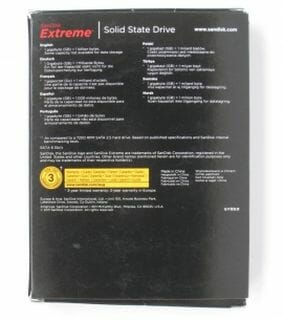
As for the contents of the box, the SSD is shipped without any handy accessories such as an adapter for installing it into a 3.5-inch bay.
The SSD itself looks like a high-quality product, though. It has a robust metallic case painted matte black. Of course, the exterior design of an SSD hardly matters for anyone, yet the Extreme does look top-class compared, for example, with OCZ products.
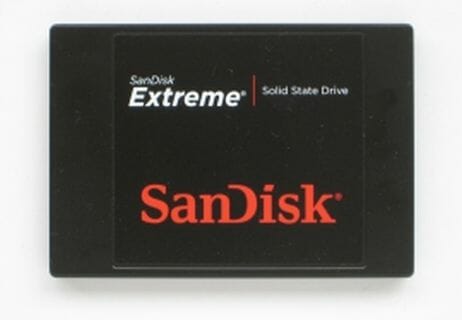
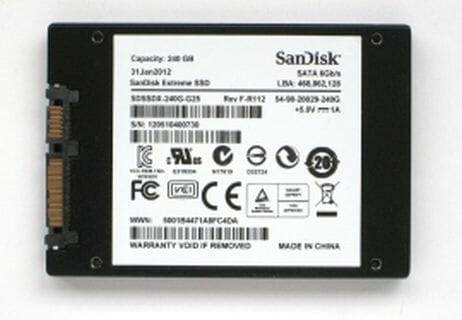
There are two labels on the case, one with manufacturer and series logos and another with technical information (part number (SDSSDX-240G), capacity, interface type, barcodes, etc). The case is 9.5 millimeters thick.
The SanDisk Extreme seems to utilize a reference PCB from the controller developer but we can’t be sure as we haven’t yet met any other SandForce-based product with 24nm Toggle Mode NAND flash. The PCB of this 240 GB disk is populated by an SF-2281 controller together with eight memory chips. There are eight empty places for more memory which is installed for the 480 GB model.
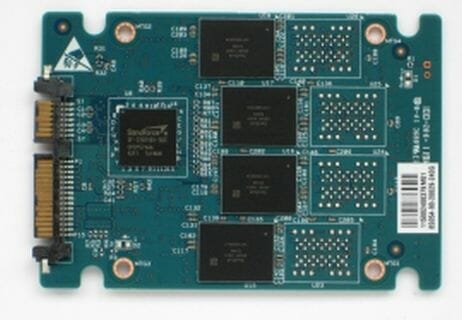
It is these memory chips that constitute the second special feature of the SanDisk Extreme. Each of them is 32 GB in capacity, containing four 64-gigabit NAND dies. Bearing SanDisk markings, the chips are actually manufactured at Fab 5 which is owned by Flash Forward Ltd, a joint venture of SanDisk and Toshiba. The pedigree is unimportant, though. The main thing is that these chips belong to the new generation: Toggle Mode HBL (hierarchical bit-line) NAND flash memory manufactured on 24 nm tech process out of 300mm wafers. It is the progressive manufacturing technology that allows this memory to compete in pricing with ordinary ONFI 2.0 flash. And that’s why the SanDisk Extreme is comparable in price with the numerous SandForce-based products that have Intel and Micron memory.
24 nm Toggle NAND flash works at a higher clock rate than synchronous ONFI 2.0 flash. However, SSDs with 24 nm Toggle NAND flash are going to be somewhat slower than their predecessors that used the 32 nm version of that memory because the introduction of the new tech process doubled the density of NAND devices and reduced the controller’s interleave level. For example, the SandForce controller uses 8-way interleave in 240 GB SSDs with 32 nm Toggle NAND flash (such as OCZ Vertex 3 MAX IOPS or Mushkin Chronos Deluxe) whereas the SanDisk Extreme 240 GB only supports 4-way interleave.
Here are the official SanDisk Extreme 240 GB specs:
- Controller: SandForce SF-2281;
- Interface: SATA 6 Gbps;
- Flash-memory: synchronous 24 nm Toggle Mode NAND;
- Size: 240 GB;
- Cache-memory: none;
- Sequential read speed: 550 MB/s;
- Sequential write speed: 520 MB/s;
- Random read speed ( 4 KB blocks): 39000 IOPS;
- Random write speed ( 4 KB blocks): 83000 IOPS.
The specifications are typical of SandForce-based solutions with synchronous flash. The capacity is standard as well. As in other SSDs based on the SandForce platform, 14% of capacity is reserved for the RAISE technology (Redundant Array of Independent Silicon Elements), so the user-accessible capacity is 240 gigabytes (or 223 gibibytes out of the full 256 gibibytes).
SanDisk offers the SSD Toolkit utility for its SSDs. It can report the exact model name of the SSD, show its SMART parameters and update its firmware.
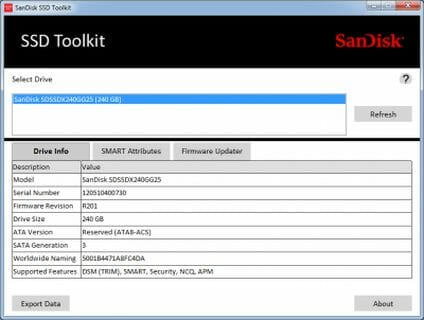
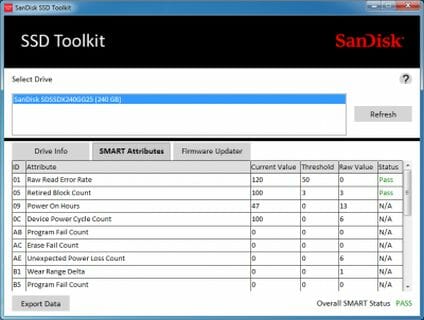
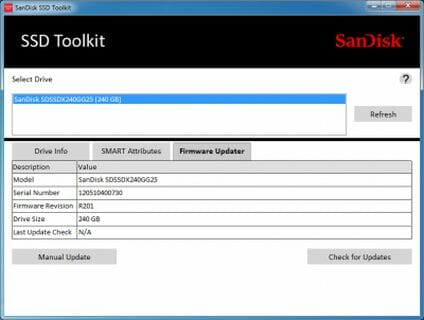
The current firmware is version R201 but the version number is the only original thing about it. It is actually based on reference firmware 5.01.
Like most SSDs with SF-2281 controller, the SanDisk Extreme is shipped with a 3-year warranty.
Testbed Configuration
For our today’s SSD test session we put together a system on an Intel H67 based mainboard. This chipset provides support for two SATA 6 Gbit/s ports, which we use to connect the tested SSDs.
We are going to compare SanDisk Extreme SSD 240 GB against the typical representatives with similar storage capacity from all four SandForce-based series. They are the unique Intel SSD 520 with its exclusive firmware; Corsair Force Series GT with synchronous ONFI memory; Corsair Force Series 3 with asynchronous memory and Mushkin Chronos deluxe with previous generation 32 nm Toggle Mode NAND. Besides we also included into the diagrams the results of a few popular SSDs based on other controllers: Crucial m4 and Plextor M3 on Marvell 88SS9174, Samsung SSD 830 using Samsung’s own controller and flash-memory, and OCZ Vertex 4 on Indilinx Everest 2.
Overall our testbed was configured as follows:
- Intel Core i5-2400 (Sandy Bridge, 4 cores, 3.1 GHz, EIST and Turbo Boost turned off);
- Foxconn H67S mainboard (BIOS A41F1P03);
- 2 x 2 GB DDR3-1333 SDRAM DIMM 9-9-9-24-1T;
- Crucial m4 256 GB system disk (CT256M4SSD2);
- Tested SSDs:
- Corsair Force 3 Series 240 GB (CSSD-F240GB3-BK, firmware version 5.02);
- Corsair Force GT Series 240 GB (CSSD-F240GBGT-BK, firmware version 5.02);
- Crucial m4 256 GB (CT256M4SSD2, firmware version 000F);
- Intel SSD 520 240 GB (SSDSC2CW240A3K5, firmware version 400i);
- Mushkin Chronos deluxe 240 GB (MKNSSDCR240GB-DX, firmware version 5.0.2);
- OCZ Vertex 4 256 GB (VTX4-25SAT3-256G, firmware version 1.5);
- Plextor M3 256 GB (PX-256M3, firmware version 1.05);
- Samsung SSD 830 256 GB (MZ-7PC256D, firmware version CXM03B1Q);
- SanDisk Extreme SSD 240 GB (SDSSDX-240G, firmware version R201).
- Microsoft Windows 7 SP1 Ultimate x64
- Drivers:
- Intel Chipset Driver 9.3.0.1019;
- Intel Graphics Media Accelerator Driver 15.22.54.2622;
- Intel Rapid Storage Technology 11.1.0.1006.
Performance
Random and Sequential Read/Write
We use CrystalDiskMark 3.0.1 benchmark to test the random- and sequential read and write speed. This benchmark is convenient to work with as it can measure the speed of an SSD with both incompressible random and fully compressible recurring data. This feature is important for testing SSDs based on SF-2281/2282 controller, which tries to compress the data before writing it into memory. So, there are two numbers in the diagrams below that reflect the maximum and minimum SSD speed. The real-life performance of an SSD is going to be in-between those two numbers depending on how effective the controller data compression is.
Note that the performance tests in this section refer to SSDs in their “Fresh Out-of-Box” state (FOB). No degradation could have taken place yet.
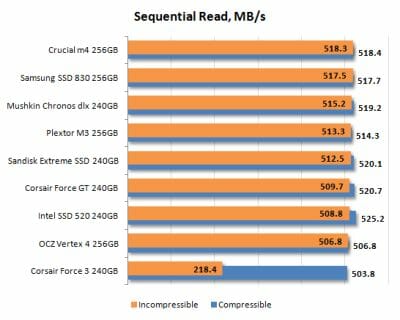
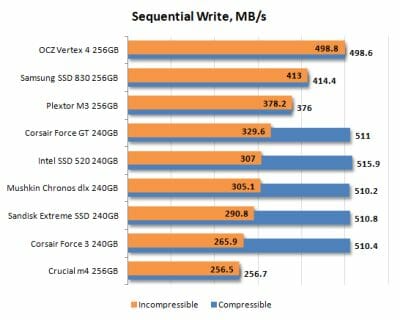
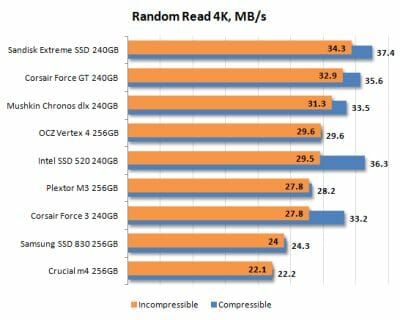
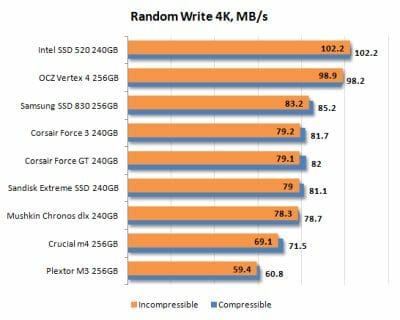
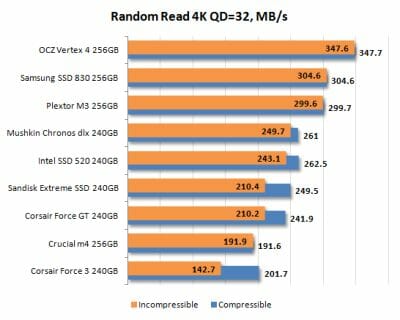
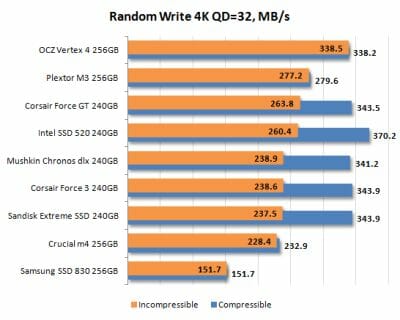
Although a new and nonstandard implementation of the SandForce platform, the SanDisk behaves in a predictable manner. It is similar to other SSDs with the SF-2281 controller. Particularly, it accelerates when processing compressible data. Well, that’s the controller’s behavior actually and the use of new flesh memory chips can hardly affect it.
Overall, the SanDisk Extreme is close to the Mushkin Chronos Deluxe across different loads. Both use Toggle Mode NAND flash, but the Mushkin has the older 32nm version of that memory. They are not identical, though. The SanDisk can deliver higher performance with random reads at a short request queue. When the queue is long, the Mushkin Chronos Deluxe goes ahead while the SanDisk slows down to the level of SandForce-based SSDs with ordinary synchronous flash.
Thus, our synthetic benchmarks suggest that the SanDisk Extreme with 24nm Toggle Mode NAND memory is somewhere in between the older SandForce-based SSDs with Toggle Mode flash and the numerous products with synchronous flash manufactured by IMFT.
Degradation and Steady-State Performance
Unfortunately, SSDs are not always as fast as in their “fresh” state. In most cases their performance goes down after some time and in real life we deal with completely different write speeds than what we see on the diagrams in the previous chapter of our review. The reason for this phenomenon is the following: as the SSD runs out of free pages in the flash memory, its controller has to clear memory page blocks before saving data into them, which causes substantial delays. Although, modern SSD controllers can alleviate the performance drop by erasing unused flash memory pages ahead of time, when idle. They use two techniques for that: idle-time garbage collection and TRIM.
Of course, users are more interested in the consistent performance of their SSDs over a long period of time rather than the peak speed they are going to see only during the initial short-term usage period, while the drive is still “fresh”. The SSD makers, however, declare the speed characteristics of “fresh” SSDs for marketing reasons. That’s why we decided to test the performance hit that occurs when a “fresh” SSD becomes a “steady” one.
To get a complete picture of SSD performance degradation we ran special tests based on the SNIA SSSI TWG PTS (Solid State Storage Performance Test Specification) methodology. The main idea of this approach is to measure write speed consecutively in four different cases. First we measure the “fresh” SSD speed. Then we measure the speed after the SSD has been fully filled with data twice. The third test occurs after a 30-minute break during which the controller can partially restore performance by running the idle-time garbage collection. And finally, we measure the speed after issuing a TRIM command.
We ran the tests in synthetic IOMeter 1.1.0 RC1 benchmark, where we measured random write speed when working with 4 KB data blocks aligned to flash memory pages at 32 requests queue depth. The test data were pseudo-random.
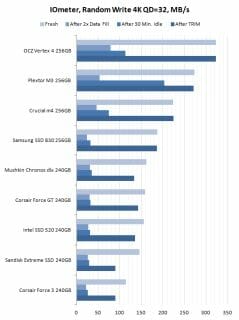
Unfortunately, the SanDisk Extreme brings no improvements in terms of the TRIM command. Every time we test a new SandForce-based product we have to complain that the controller developers can’t make their garbage collection algorithms as efficient as in other controllers. The steady-state performance of every SandForce-based SSD is lower than its out-of-box performance, which is sad.
And the saddest thing about the SanDisk Extreme is that its TRIM and garbage collection are even worse than in other SSDs with the same controller, so its performance hit is heavier. Well, this downside is rooted in firmware, so we can expect the SanDisk Extreme to improve with firmware updates. It currently uses reference firmware 5.0.1 whereas most other SandForce-based SSDs have already transitioned to firmware 5.0.2 in which this problem has been somewhat alleviated.
Since the characteristics of most SSDs do change once they transition from fresh out-of-the-box state into steady state, we measure their performance once again using CrystalDiskMark 3.0.1 benchmark. The diagrams below show the obtained results. We use random data writing and measure only performance during writes, because read speed remains constant.
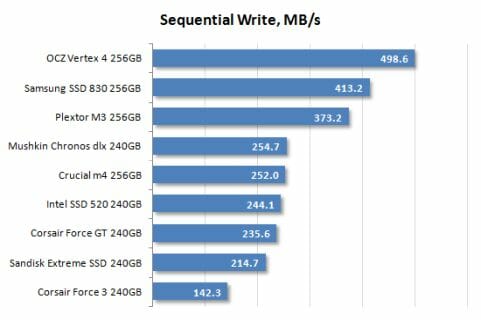
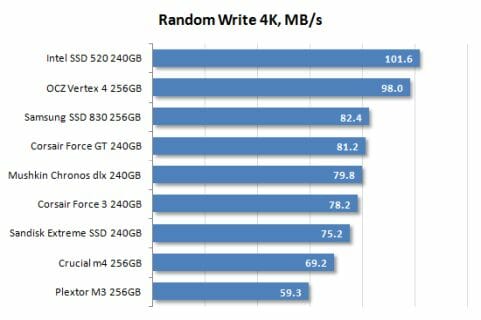
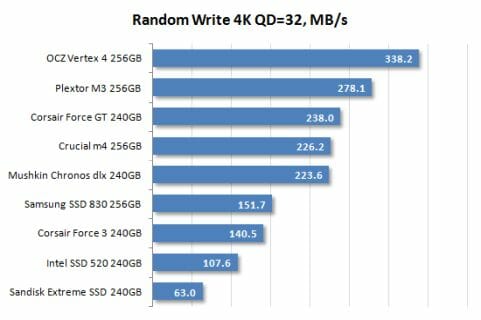
The diagrams confirm our point. The steady-state performance of the SanDisk Extreme is much lower than what it might deliver with the newer firmware. The current version is dated the end of April and SanDisk doesn’t seem to be too eager to upgrade it.
Futuremark PCMark 7
The popular PCMark 7 contains an individual disk subsystem benchmark. It is not a synthetic test, but is based on real-life applications. This benchmark reproduces typical disk usage scenarios and measures how fast they are completed in popular applications. Moreover, the disk access commands are not executed as a steady uninterrupted flow, but in a more realistic manner – with certain pauses caused by the need to process the data. The benchmark generates an overall disk subsystem performance rating as well as speed readings in MB/s in individual usage scenarios. Note that the absolute speed in these scenarios is not too high because of the above mentioned pauses between individual input/output operations. In other words, PCMark 7 shows you the speed of the disk subsystem from the application’s point of view. Numbers like that show us not only the pure performance of an SSD, but mostly how big of a performance gain a certain SSD can guarantee in real life.
We ran PCMark 7 on “steady” SSDs, which is what they are going to be in actual computer systems most of the time. Their performance in this case is affected not only by their controller or flash memory speed but also by the efficiency of their internal algorithms that fight performance degradation.
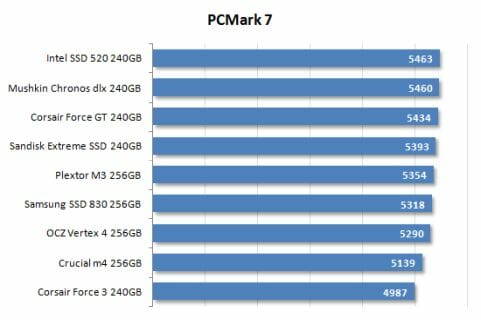
Against our expectations, Futuremark PCMark 7 gives the SanDisk Extreme a rather low performance score. The SSD is inferior to the Mushkin Chronos Deluxe as well as to the Corsair Force GT, yet it is still in the top part of the diagram and looks good compared to SSDs based on other platforms.
Now let’s check out the individual tests to get a more detailed picture of what our SSDs are capable of under various types of operational load:
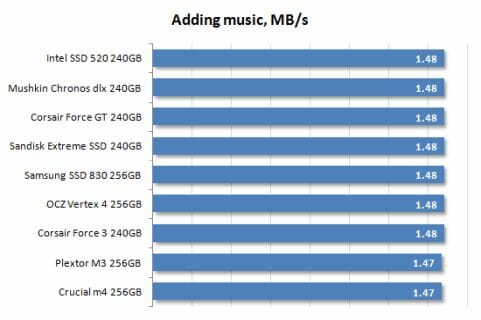
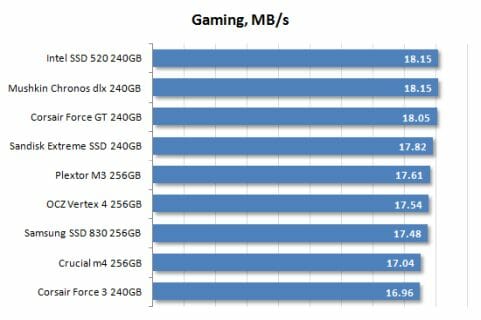
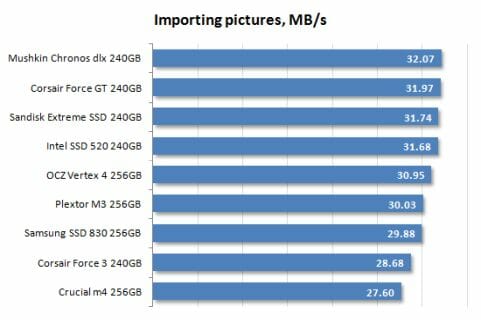
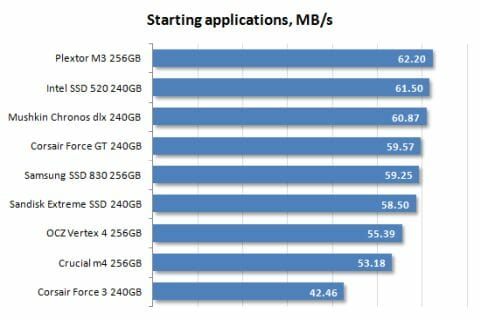
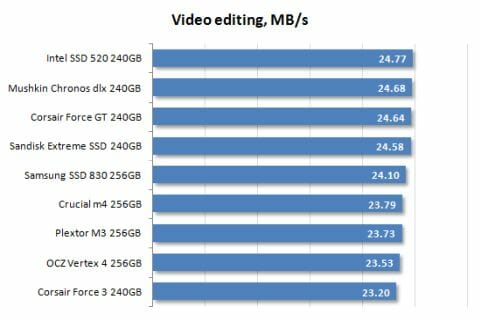
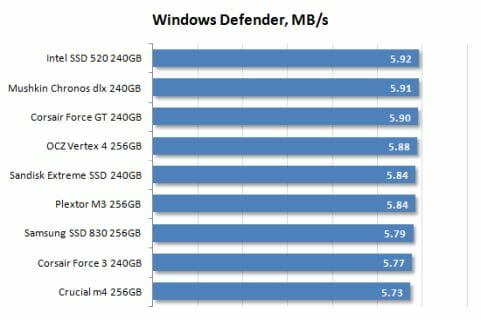
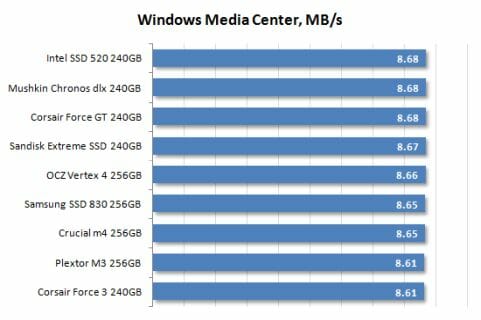
The SanDisk Extreme performs consistently throughout all of the PCMark 7 traces. It can’t win any of them. Considering that we test SSDs in their steady state, this must be due to the abovementioned problem with the TRIM command implementation.
Intel NAS Performance Toolkit
Intel NASPT is another disk sub-system test that uses real-life usage scenarios. Like PCMark 7, Intel NASPT reproduces predefined disk activity traces and measures how fast they are executed. However, the default traces are designed for network attached storage devices rather than for SSDs. Therefore during our test session we replace them with the specially developed SSD Benchmarking Suite which offers more relevant usage scenarios such as compressing and decompressing files, compiling large projects, copying files and folders, loading 3D game levels, installing software, batch-processing photos, searching a digital library for data, mass-launching applications, and transcoding video.
Like PCMark 7, this benchmark gives us a true-to-life illustration of disk subsystem performance. Here the SSDs are again tested in their “steady” state.
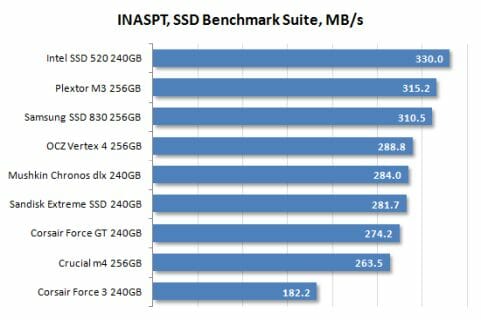
Intel NAS Performance Toolkit is more positive about the SanDisk Extreme than PCMark 7, putting it between the Mushkin Chronos Deluxe (32nm Toggle Mode NAND flash) and the Corsair Force GT (25nm synchronous ONFI flash). This agrees with the results of our synthetic benchmarks.
The detailed INASPT results help us see what usage scenarios are the most suitable for our today’s testing participants. Take note that the data-transfer rate is higher than the SATA III interface bandwidth in some subtests. That’s because INASPT is a high-level test that uses standard Windows functions to access the disk subsystem. As a result, the OS caching mechanisms also affect the results.
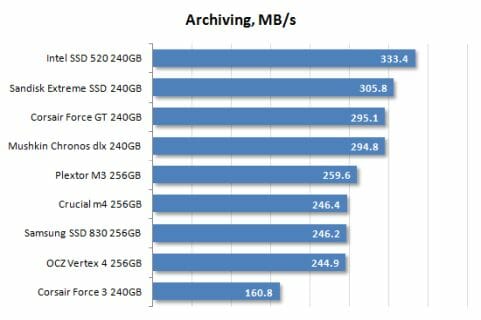
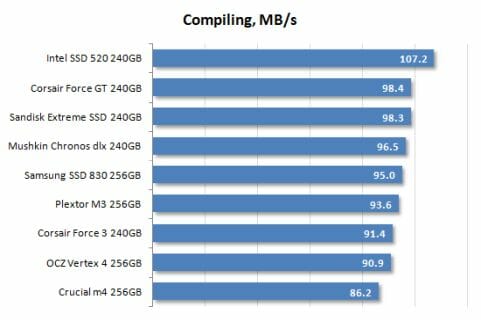
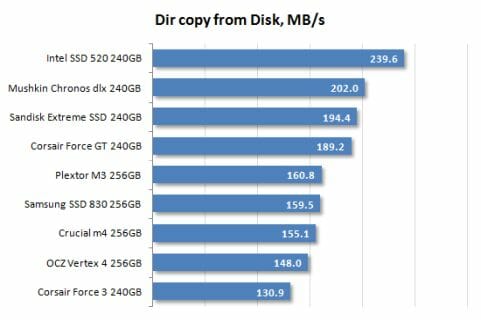
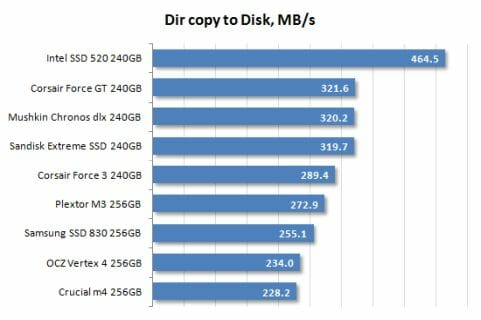
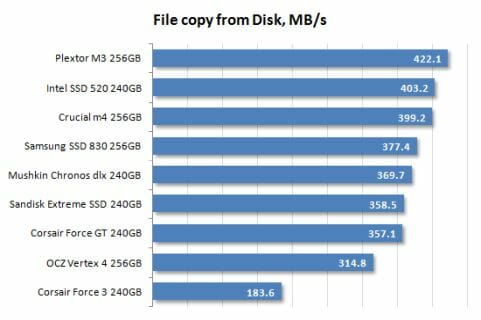
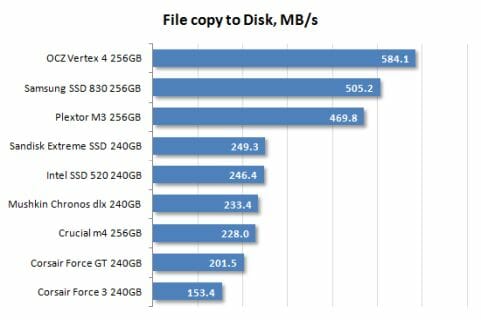
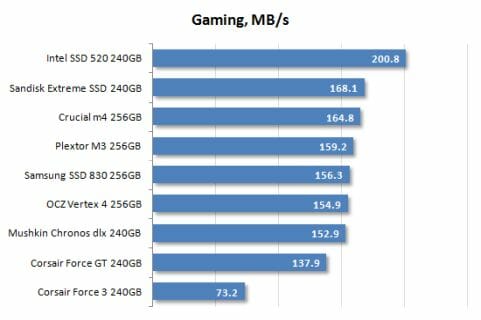
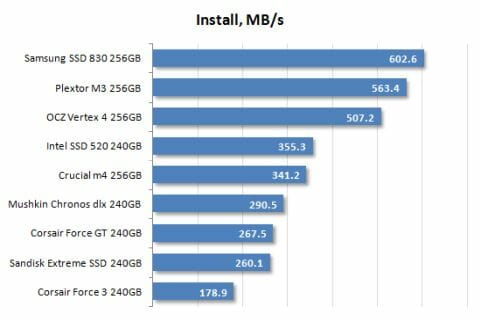
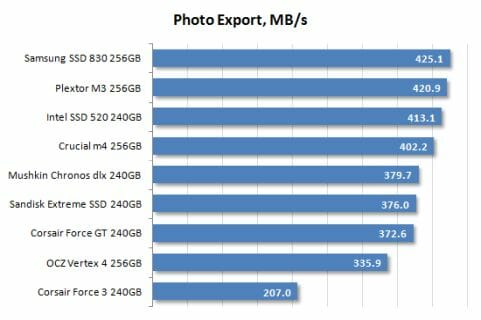



We have different standings in the different scenarios, but there are a number of tasks at which the new SandForce implementation with 24nm Toggle NAND looks better than others. These are such tasks as archiving, copying of a large file from the SSD, gaming, loading of the OS and applications, and video transcoding. Of course, the Intel SSD 520 remains the fastest SSD with SF-2281 controller, yet the SanDisk Extreme looks good among the products with reference firmware.
File Copying
We use AS SSD version 1.6.4237.30508 test to benchmark the speed of copying files within a single partition the size of the whole SSD. The SSDs are tested in their steady state.



We don’t see anything new in the copying tests. SandForce-based SSDs aren’t fast at copying files due to their relatively low write speed. The SanDisk with its suboptimal TRIM implementation is far from impressive, too. We must note, however, that the AS SSD benchmark uses files with incompressible data. We’d have different standings if the controller had the opportunity to compress data written into flash memory.
Conclusion
There have been changes in the SandForce realm. Products with old 32nm Toggle NAND flash memory have given way to the new generation of SSDs with 24nm Toggle Mode HBL memory. In this review we’ve tested the first representative of that generation, the 240GB Extreme SSD from SanDisk, but other brands will surely follow suit soon.
According to our tests, the SF-2281 controller works well with 24nm Toggle Mode NAND flash. This combination of components results in a competitive product with typical SandForce features. However, the new SSDs are not identical to their predecessors with 32nm Toggle NAND. The 24nm memory is designed as 64-gigabit dies, limiting the controller’s ability to interleave memory access. As a result, these new SSDs the SanDisk Extreme is an example of are not as fast as the older ones with 32nm Toshiba chips (such as OCZ Vertex 3 Max IOPS, Patriot Wildfire or Mushkin Chronos Deluxe). On the other hand, they are still faster than mainstream SSDs with synchronous memory and ONFI interface, even though this advantage has shrunk to a minimum.
From an end-user’s point of view, it is important that the new manufacturing technology helps make the end product cheaper, so the new SSDs with 24nm Toggle Mode NAND can be positioned in the same market segment as inexpensive SandForce-based products with synchronous memory. Considering their performance, this may lead to SSDs with a highly appealing price/performance ratio, like the SanDisk Extreme. This specific model has one downside, though. It suffers a heavy performance hit as it transitions from its out-of-box to steady state. This downside can be eliminated by firmware updates although SanDisk doesn’t seem too eager to do that. So, the SanDisk Extreme is an attractive product potentially, yet we wouldn’t recommend buying it right now. It’s wiser to wait for similar products from other brands.

Some time ago we started to fill in a summary table with test results of various SandForce-based SSDs. Now that there are other controllers available, we add them into that table as well. So, the updated table contains the basic hardware information about the tested SSDs and allows to quickly determine the general position of a particular model among its competitors in terms of relative performance.
